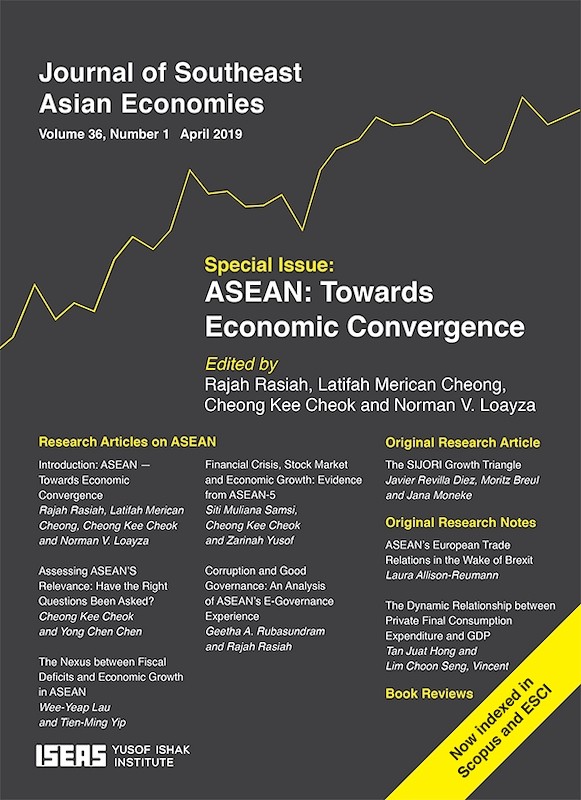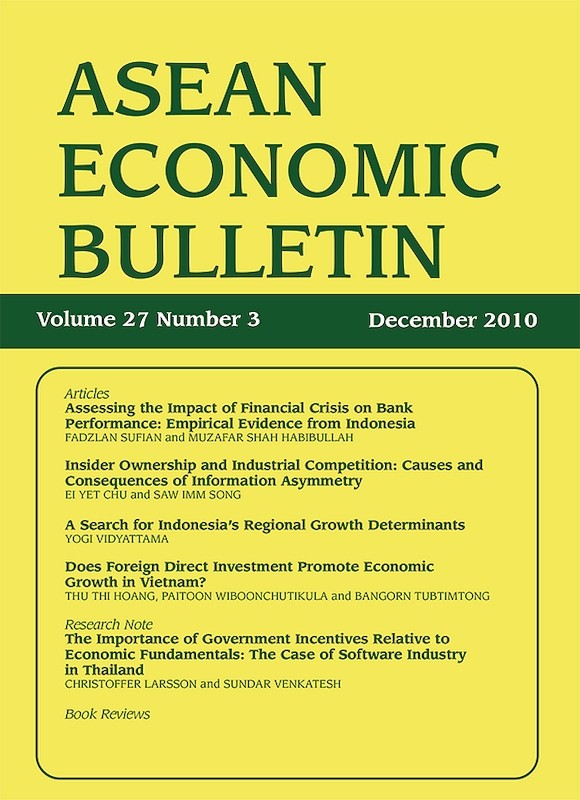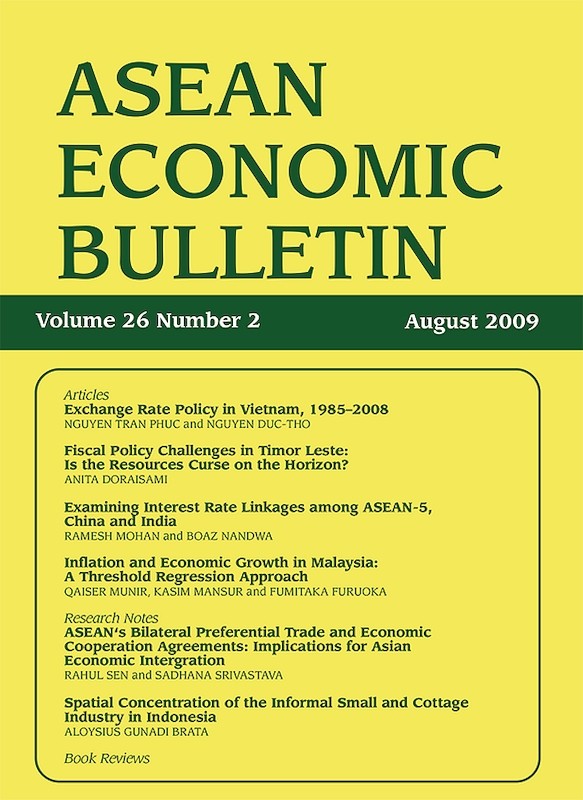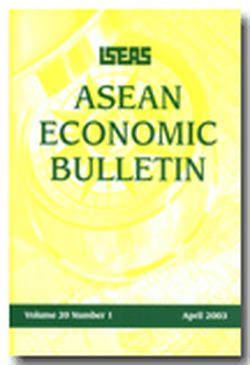Journal of Southeast Asian Economies Vol. 36/1 (Apr 2019). Special Issue on "ASEAN: Towards Economic Convergence"

Date of publication:
April 2019
Publisher:
ISEAS – Yusof Ishak Institute
Number of pages:
139
Code:
AE36/1
Contents
-
Journal of Southeast Asian Economies Vol. 36/1 (Apr 2019). Special Issue on "ASEAN: Towards Economic Convergence"
[Whole Publication, ISSN: 23395206] -
Preliminary pages
- ASEAN: TOWARDS ECONOMIC CONVERGENCE
-
1. In Memoriam: Latifah Merican Cheong, by Rajah Rasiah, Cheong Kee Cheok, Norman V Loayza, authors
-
2. Introduction: ASEAN — Towards Economic Convergence, by Rajah Rasiah, Latifah Merican Cheong, Cheong Kee Cheok, Norman V Loayza, authors
-
3. Assessing ASEAN’S Relevance: Have the Right Questions Been Asked?, by Cheong Kee Cheok, Yong Chen Chen , authors see abstractWhen ASEAN celebrated its fiftieth anniversary, it was asked if an organization founded on principles appropriate for the 1960s remains relevant today. Its critics point to the organization’s recent failures to indicate that continued reliance on the “ASEAN Way” puts it on the road to irrelevance. Its defenders argue that the peace and stability that ensued since the Association’s formation are testimony that the ASEAN formula works. Both conclusions are based on what commentators on either side of the debate believe ASEAN’s role should be. This paper argues that an assessment should, instead, be based on what its members want it to do, expressed through policy announcements and documents like the ASEAN Charter. It should also consider the totality of its mandate from diplomacy to economics. Viewed in this way, the grouping has accomplishments to be proud of, but also some failures to regret. The “ASEAN Way", upheld steadfastly by its member countries’ leadership, has been instrumental to both its successes and failures. Overall, while ASEAN may not live up to the expectations of its critics, its achievements in some areas do suggest its continued relevance even under vastly changed circumstances, both domestic and external.
-
4. The Nexus between Fiscal Deficits and Economic Growth in ASEAN, by Lau Wee Yeap, Yip Tien Ming, authors see abstractThis study provides new evidence on the nexus between fiscal deficits and economic growth among ASEAN countries in the pre- and post-Global Financial Crisis (GFC) periods. Using annual data from 2001 to 2015, three results stand out. First, fiscal deficits are found to be growth-deteriorating in the pre-Crisis period and growth-enhancing in the post-Crisis period. Second, the impact of fiscal deficits on growth in pre- and post-GFC are robust to different measures of economic growth. Third, among control variables, inflation is important in influencing economic growth in the pre-Crisis period while exchange rate and inflow of foreign direct investment have a positive impact on growth in the post-Crisis period.
-
5. Financial Crisis, Stock Market and Economic Growth: Evidence from ASEAN-5, by Siti Muliana Samsi , Cheong Kee Cheok, Zarinah Yusof , authors see abstractThis paper examines the effects of the Asian Financial Crisis (AFC) and Global Financial Crisis (GFC) on economic growth in the ASEAN-5 countries. Indonesia, Malaysia and Thailand were found to be most affected by the AFC but not the GFC. Additionally, for Malaysia and Thailand, real output responded positively and significantly to shocks in the stock market. These findings are consistent with the results that show that the shock in the Kuala Lumpur Stock Exchange has a larger effect on real output than other variables for twenty periods. However, a shock in the Bangkok stock exchange has a higher effect on real output and the effect remained strong until the tenth period. This suggests that the stock market is an important economic growth driver in Malaysia and Thailand.
-
6. Corruption and Good Governance: An Analysis of ASEAN's E-Governance Experience, by Geetha A Rubasundram , Rajah Rasiah, authors see abstractSince its formation in 1967, the Association of Southeast Asian Nations (ASEAN) has progressed to become an economic powerhouse. From a loosely formed grouping in the 1960s, its members have since undergone massive integration. A key motive of the Association is to transfer government and public services onto a technology platform, termed e-government. An important concern is whether e-governance can reduce corruption and stimulate sustainable development. Using traditional governance measures and e-governance indices, this paper analyses the state of governance and corruption in ASEAN. While the deepening of e-governance — via government and public participation — has raised the potential for improving good governance practices, that in itself can be counterproductive as socioeconomic agents could broaden corrupt practices by appropriating its public-good-like characteristics. Hence, ASEAN governments have to implement changes in their communications strategies and feedback mechanisms, remove barriers blocking the spread and use of information technology, and promote a collaborative environment with civil society organizations, while considering the use of the “carrot and stick” approach to improve good governance.
- ORIGINAL RESEARCH ARTICLE
-
7. The SIJORI Growth Triangle: Territorial Complementarities or Competitionfor FDI in the Oil and Gas Industry?, by Javier Revilla Diez , Moritz Breul , Jana Moneke , authors see abstractAfter some initial euphoria, the SIJORI Growth Triangle — formed by Singapore, Johor (Malaysia) and Riau Islands (Indonesia) — seems to have been forgotten. The growth triangle concept was developed to enhance the attractiveness of the three territories for foreign investment. This paper aims to explore whether firms in the oil and gas industry are making use of the different factor endowments accessible in close spatial proximity. Based on FDI data and expert interviews, it is observed that Singaporean firms are, in fact, taking advantage of the different factor endowments that SIJORI offers, especially in sectors related to storage and and offshore equipment manufacturing. However, in the case of Johor and Riau Islands, the focus continues to be on lower value-added activities.
- ORIGINAL RESEARCH NOTES
-
8. ASEAN’s European Trade Relationsin the Wake of Brexit, by Laura Allison-Reumann , author see abstractThe reaction within Southeast Asia from business and policy leaders to the United Kingdom’s decision to exit the European Union has thus far been one of disappointment rather than panic. How Brexit will affect a possible EU–ASEAN free trade agreement, bilateral trade deals in the region, foreign direct investment flows between ASEAN and the U.K. and the EU, and the U.K.’s future trade arrangements remains uncertain. This article examines how the U.K.’s departure from the Union will affect ASEAN and its member states in terms of European trade, and its impact on the U.K.’s and the EU’s trade relations with Southeast Asia. It is argued that ASEAN is far from being immune to the effects of Brexit on financial markets and trade configurations. However, given the diversity of trade and investment among the ASEAN member states, aggregated regional effects and member-state effects will differ. The findings also suggest that there will be political and security considerations for ASEAN and its member states whilst the U.K. tries to establish itself as an independent trade actor post Brexit.
-
9. The Dynamic Relationship betweenPrivate Final Consumption Expenditureand Gross Domestic Product: Evidence from Colonial Malaya and Post-independence Malaysia, by Tan Juat Hong, Lim Choon Seng, Vincent, authors see abstractUsing a panel cointegration approach, this study examines the relationship between aggregate consumption and GDP in colonial Malaya (1900–39) and post-independence Malaysia (1970–2009). The findings suggest that private consumption and GDP are cointegrated across the two forty-year periods, indicating a stable relationship in the long run. This is significant as the two periods are completely bipolar in terms of economic structure, stage of development and economic management. The vector error-correction models reveal that adjustment to long-run equilibrium is achieved through changes in both consumption and GDP, though the response of GDP to disequilibrium is stronger. Cointegration regressions of DOLS and FMOLS are used to estimate the marginal propensity to consume (MPC) between the two periods.
- BOOK REVIEWS
-
BOOK REVIEW: Dictators, Democrats and Development in Southeast Asia: Implications for the Rest, by Michael T. Rock. , by Lorraine Carlos Salazar, author
-
BOOK REVIEW: Understanding China: Chinese Global Production Networks in ASEAN, edited by Young-Chan Kim. , by V.G.R. Chandran Govindaraju , author
-
BOOK REVIEW: The Rise of the Hybrid Domain: Collaborative Governance for Social Innovation, by Yuko Aoyama with Balaji Parthasarathy. , by Himanshu Jha, author
-
BOOK REVIEW: Economic Development: What Everyone Needs to Know, by Marcelo M. Giugale. , by Wannaphong Durongkaveroj, author
-
Thank You List




![Journal of Southeast Asian Economies Vol. 30/1 (Apr 2013) [formerly ASEAN Economic Bulletin]](/cover/AE30-1.jpg)

